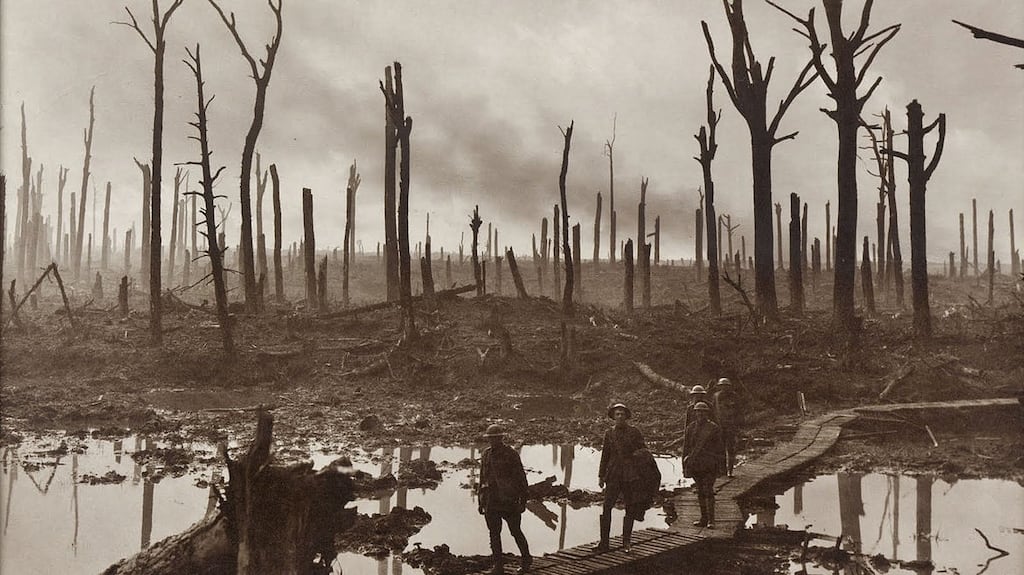In October 1917 the Canadian commander-in-chief Sir Arthur Currie arrived in Flanders to be told that his men would have to take the village of Passchendaele.
Currie was aghast at what his orders meant. After four months of fighting in terrible conditions, Flanders was a stinking sty of a place, a hellhole of water-filled craters, withered tree stumps and an ocean of mud.
Unburied bodies were everywhere. When the ground did not yield, soldiers knew they were walking on the corpse of a man.
Friend and foe alike were repulsed by the ghastly conditions in which the British and their Commonwealth allies were locked into a death grip with the German defenders. One Canadian infantryman said none acquainted with their ultimate goal expected to come back alive. “Each and every man felt it was a sure death trap”.
Currie looked towards the remains of Passchendaele village at the top of Passchendaele Ridge and concluded it was worth “not one drop of blood”. Passchendaele was a village in name only. All that was left was the ruins of homes which were turned into fortified bunkers.
Currie’s fellow general Sir Hubert Plumber concurred with him, but said those were his orders. They came from the British commander-in-chief Field Marshal Sir Douglas Haig, whose bloody-minded pursuit of the Flanders offensive long after its useful purpose had expired will forever be a stain on his reputation.
The Canadian Corps began its assault on October 26th. Every metre of sodden ground was gained only with terrible casualties. Finally on November 6th, the Canadians captured the ruin of Passchendaele village. One last push, which finished on November 10th, consolidated the line.
In three months and 10 days of fighting, the British had moved the frontline eight kilometres. Nearly 100,000 British and Commonwealth soldiers were killed. The Germans lost half that number. Currie, with wearying prescience, predicted the assault on Passchendaele village would cost 16,000 casualties. It cost 15,634.
The last day of Passchendaele took a terrible toll on the Irish too. The 1st battalion of the Royal Munster Fusiliers was part of the 1st Division and it was pressed into the attack in support of the Canadians.
The Munsters’ official history recorded the men walking in the pitch dark and the pouring rain to their starting positions. The soil had the consistency of glue and yet the men were forced to carry with them a full marching pack, rations for three days, 150 rounds of ammunitions, two Mills bombs and two water bottles.
“Never have troops gone into action carrying a heavier load under worse conditions,” the history concludes. “They pressed forward in mud-bespattered, bloodstained, sodden groups.”
The attack began at 6am on November 10th, 1917, in the most horrendous conditions imaginable. The men were quickly up to their waists in mud.
The creeping barrage – shells fired ahead of the advancing infantry to subdue the defender – was measured at 100 metres every few minutes, yet that was faster than the Munsters could advance. The men were also bombed from the air.
Nevertheless, the attackers took their objectives by 6.45am, including a pillbox taken at the point of a bayonet.
They were now exposed to a counter attack. The SOS rocket party had vanished and four carrier pigeons were dispatched.
Runners trudged back through the sludge to call for reinforcements.
The Germans counterattacked at 7.30am, and the Irish learned to their horror that they had nothing to fight back with. Every rifle, machine gun and revolver was clogged with mud. They were out of Mills bombs.
Instead, their commanding officer, Capt Arthur Batten-Pooll, a Victoria Cross winner from earlier in the war, improvised the response.
He ordered his men to throw mud balls at the German counter-attackers. Thinking the clods of earth were bombs that had simply not exploded because of the muddy conditions, the Germans fell back. The ruse had worked.
The attack lasted another four hours. The isolated Munsters had to contend with not only being strafed from the air by passing German planes too, but by friendly fire. Because no message had got back to headquarters, the British artillery did not know the Munsters were occupying positions previously held by the Germans.
Eventually reinforcements arrived. All objectives were captured before the survivors trudged back to Irish Farm at Ypres, where their headquarters were based at 1am the next morning.
The attack took a fearsome toll on the Munsters. Of the 650 men or so available when the attack started, just 247 answered to their name the following morning. Passchendaele cost the Munsters 405 casualties. Among them were nearly 200 prisoners, and to what end?
Passchendaele Ridge was a precarious position. When the Germans began their Spring Offensive in March 1918, the British abandoned it.
Nearly 5,000 Irishmen or men in Irish formations were killed in the Battle of Passchendaele.
They are remembered in a new memorial erected on the site where the 16th (Irish) Division and 36th (Ulster) Divisions were slaughtered during the attack on Frezenberg Ridge in August 1917.
The last day of Passchendaele was much like the first – a morass of mud and blood.
Those who fought there, many of them hardened veterans, were embittered by their ordeal. Passchendaele had been a terrible mistake.
The images of men and beast floundering in the mud would forever represent the first World War in the public imagination. The poet Siegfried Sassoon wrote of men drowning in mud-filled trenches – “I died in hell (they called it Passchendaele)”.










